
English Version
Old Trees in The Netherlands and Western Europe
England 1 - Fredville Park, Kent
In Great Britain there are
still many ancient trees. The British even think their country
has more old trees than the whole rest of Europe together.
Probably this is not true, especialy in parts of Germany, Poland,
Sweden and Czechia there are also a lot of old trees to be found.
Also it will not be true for forest-trees. Still, for solitarian individual trees this idea is not so strange: in
the numerous estates in Britain there are countless solitarian trees and small groups of trees, wich are characteristic for a
great part of the English Landscape. Besides the
British have a great tradition in preserving old traditions and
culture: the typical British Landscape they see as an important
part of their culture. Ancient trees are an indispensable part of
this landscape.
The most important tree is of old the oak, for that reason called
the English
Oak. In
most parts of Britain it is the commonest tree, solitarian as
well as in hedges, small groups, woods and forests. In some areas
there are many ancient oaks , for example in Windsor Great Park and Staverton
Park in Suffolk. In both parks there are
thousands of gnarled ancient oaks, many of them pollarded. The
greater part of the old, big British Oaks have been pollarded.
The British think pollarding extensions the live of oaks.
Probably this is true, the short, pollarded trees are less easy
blown down by storms than tall maiden trees. Still, in the rest
of Europe there are some striking big old oaks wich never have
been pollarded but seem to be just as old as the oldest British
Pollards.
In former times another very important tree in Britain was the
Elm-tree. Alas the Dutch Elm
disease killed millions of them last century:
large, old Elms are very scarse nowadays, exept for Scotland,
where the disease never became so strong. Of the native
tree-species the most important in the landscape are Beech,
Lime and Ash,
but none of them have comparable numbers of ancient individuals
as the Oak.
Probably the oldest British trees are the enormous big Yews,
nearly all of them in churchyards. According to some
investigators these should date from before Christ: older than
the churches wich they accompany and wich should have been build
near the Yews instead of the reverse. You can see some old Yews on the second
page on English trees and other specimen and a discussion about their age at the
website of the Tree
Register of the British Isles.
On estates and in parks there
can be seen many big Sweet Chestnuts and
exotes like Cedar of Lebanon, London Plane ,
Giant Sequoia , Douglass-fir , Grand Fir, Sitka Spruce, Monterey
Cypress, etc. Below you can meet some
tree-veterans of England.
"Majesty" The Fredville Oak, Kent, England
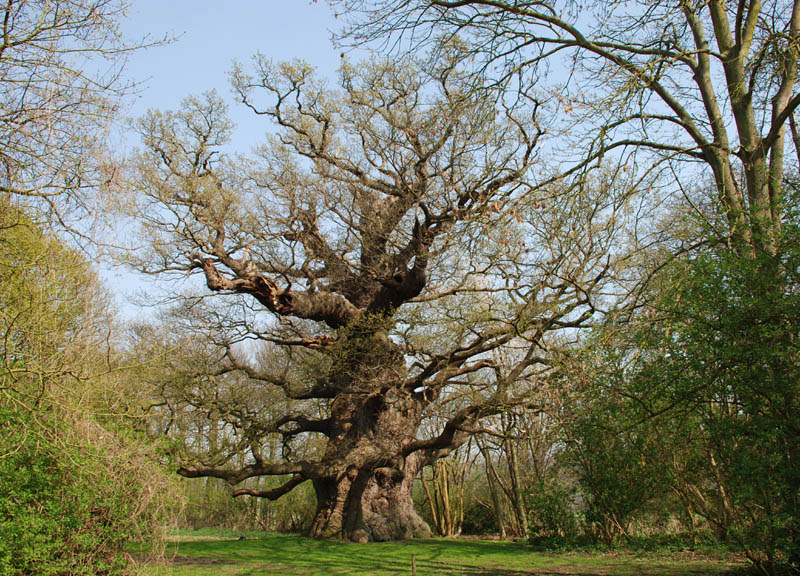
In Kent, between Dover and Canterbury, the small village Nonington lies. Just to the south of the village the Estate Fredville Park can be found, home to several ancient trees. The mightiest tree of Fredville Park is Majesty, the Fredville Oak: according to the famous dendrologist, the late Alan Mitchell, (lit.9), en many with him, the most impressive of all British Oaks. Its enormous trunk has a circumference of 12,3 m (40 feet). There are six oaks in Britain wich have an even somewhat bigger girth, but these are all short-trunked pollards, whereas Majesty is a 'maiden tree' with a long trunk up to 9 m ( 30 feet) height. In total the tree is 18 m (60 feet) tall. The only oaks I have seen in Europe wich are as impressive are the great oak of Ivenack, Germany and one Polish giant oak. At the north-side of the trunk is a big hole: it is hollow all over.
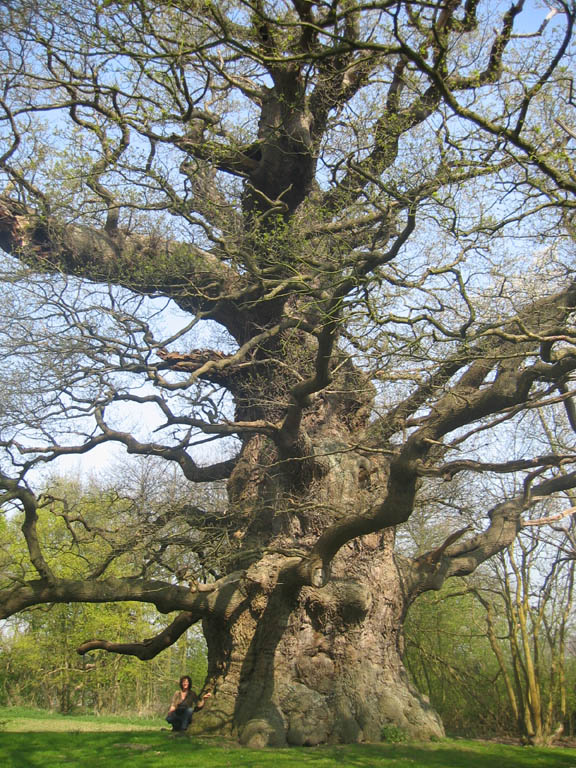
Recently (june - july 2005) the famous American tree-expert Robert van Pelt
(writer of Forest
Giants of the Pacific Coast)
visited the UK and many old trees among wich Majesty. He estimates
the oak to have a total volume of about 3300 cubic feet or 93.4 cubic meter,
wich will be one of the largest in the UK. He saw one larger volume oak (a Sessile oak) at Croft Castle of
35 meter (115 feet) tall with cbh of 8,6 meter (28,2 feet), wich had a volume of
3800 cubic feet (107.6 cubic
meter).
Sadly he also thinks Majesty will collapse any year now because of
its hollow trunk.
Myself I think this tree could stand for at least several decades more, because
the trunk is closed for a great part and, as contrasted with a recently
collapsed oak at Powis Castle called The Giant, has no extremely heavy limbs to
carry. If the largest lims should break off, the tree still has a good
chance to survive.
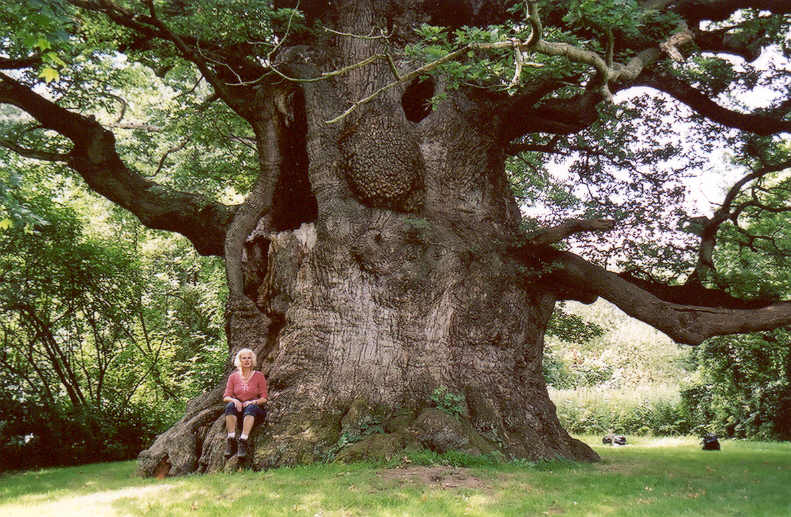
About the age of Majesty there is much divirsity of opinion: Alan
Mitchell thought, based upon its quick growth in girth of over 2
cm a year since 1820 , that it could not be much older than 450
years, others think it should be 1000 years. At a sign about the history of
Nonington and Fredville Park is written: 'It is known to have been florishing
in 1554 and was described as "healthy and thriving" in 1800'. When
this is right it should date from 1500 at least. To me a planting date between
1400 and 1500 seems reasonable. This is also the estimate of the retired dendrologist of Westonbirt Arboretum,
John White (lit.17). Still for many people this is younger than they expect, in view of the enormous trunk.
Till recently Majesty was quite
anonymous: even in the village nearby many villagers did not know
of its existence. Since Thomas Pakenham payed attention to it in his great book
'Meetings with remarkable trees' it gets more visitors, even groups from Holland
as well as Japan! The owner however cherishes it and the other
trees: it is forbidden to do any of the trees harm. More pictures of Majesty the Fredville Oak and the
other Champion Oak of Britain, the Bowthorpe Oak.
Nearby two other big oaks were given the names 'Beauty' and 'Stately'. Beauty
was taller but less big. It is fallen some years ago. Stately is thriving still
in the woodland behind Majesty and has a girth of 7,5 m.
Sweet Chestnuts in Fredville Park
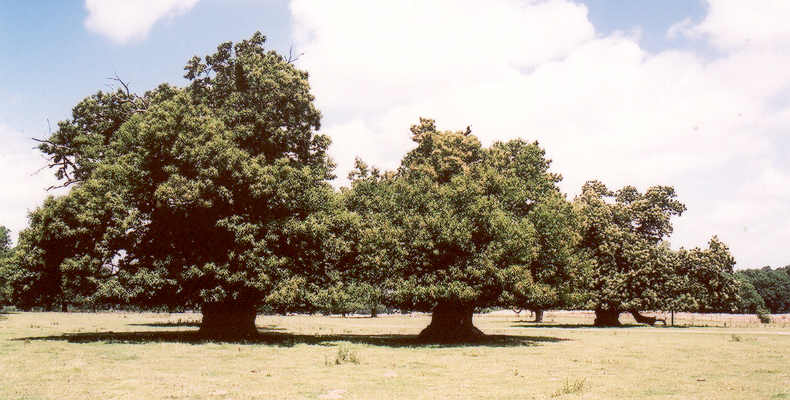
In Fredville Park some more old oaks can be found, but also several beautiful big Sweet Chestnuts. Although it is a species of Southern European origin, on many estates in Great Britain old specimens of the Sweet Chestnut can be found. Probably they were already introduced by the Romans. In remains of Roman camps traces of Chestnuts have been found. Although the Fredville chestnuts are quite big, with a circumference of up to 9,6 m (31,5 feet), they are not from Roman times. Chestnuts often grow quite fast, so these trees are probably not much older than 300 years and planted around 1700.
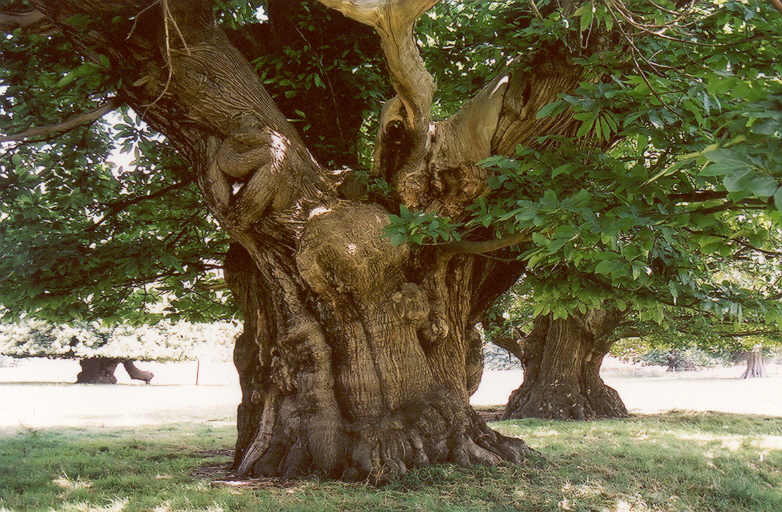
The biggest of the Fredville Chestnuts (CBH 9,6 meter) with a beautiful rugged trunk. In one of the chestnuts, called the Step-tree, formerly a staircase was build: between 12 and 20 persons could sit in the crown.
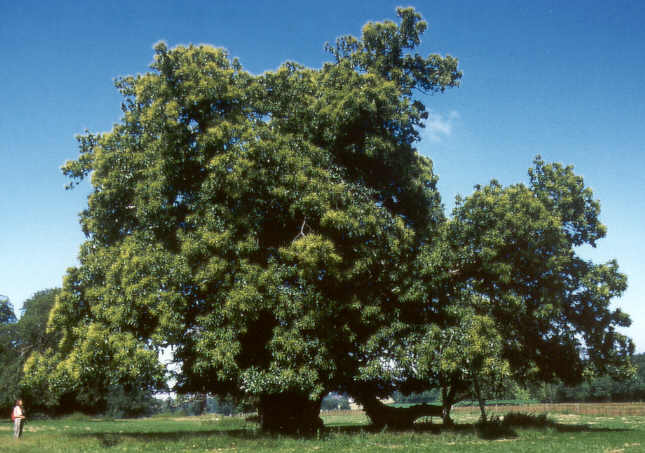
Another beautiful old Chestnut with a girth of 8,5 meter. This was probably the Step-tree. From the looks of these Chestnuts I'm not sure if they once have been pollarded. When grown up in the open Sweet Chestnuts often have a low, broad apearance also when never pollarded.
Home Dutch Version -----------------------Home English Version
Web design Jeroen Philippona - (c) 2001- 2008
If you have any remarks on this website or if you want to share any tree-information you can mail me at: